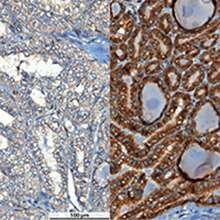Biomarker reveals cause of thyroid carcinoma

The expression of the protein CLIP2 provides information on whether a papillary thyroid carcinoma was induced by radiation or had a sporadic origin. With this discovery, scientists from the Helmholtz Zentrum München have identified a new biomarker for the diagnosis of the cancer cause. Their findings have been published in the journal Oncogene.
CLIP2 serves as a radiation marker: After exposure to radiation from radioiodine, both the genetic activity and the protein expression are increased, as the scientists' studies were able to substantiate.
CLIP2 appears to be particularly significant in the development of tumours in the thyroid gland after radiation exposure. The team around Martin Selmansberger, Dr. Julia Heß, Dr. Kristian Unger and Prof. Dr. Horst Zitzelsberger from the Radiation Cytogenetics Research Unit at the Helmholtz Zentrum München discovered a connection between high CLIP2 levels and the radiation history of patients with papillary thyroid carcinoma. "In our study, we were able to verify radiation-associated CLIP2 expression at the protein level in three different cohorts of patients with thyroid carcinoma," reports first author Selmansberger. The research paper was prepared at the Helmholtz Zentrum München in cooperation with the Institute of Radiation Protection and the Analytical Pathology Research Unit.
Radiation marker CLIP2 allows distinction of cancer cause and risk assessment
"CLIP2 serves as a radiation marker and allows us to distinguish between radiation-induced and sporadic thyroid carcinomas," adds study leader Heß. In their investigations, the scientists developed a standardized method to determine the CLIP2 biomarker status. "This biomarker allows us both to draw conclusions about the mechanisms involved in the development of such tumours and to evaluate the risk of thyroid cancer after exposure to high level radiation, for instance, following a radiation accident," reports Heß.
The Helmholtz Zentrum München focuses its work in health research on major widespread diseases. In addition to diabetes and lung diseases, this also includes cancer. The objective of the Helmholtz Zentrum München is the rapid further development of the results of basic research in order to provide benefits for society.
The exact function of CLIP2 in the carcinogenesis of thyroid carcinoma is unknown. Reconstruction of the CLIP2 gene regulatory network suggests, however, that CLIP2 is involved in fundamental carcinogenic processes and that it consequently contributes to tumour development.
More information: Selmansberger, M. et al. (2014). "CLIP2 as radiation biomarker in papillary thyroid carcinoma," Oncogene, DOI: 10.1038/onc.2014.311















